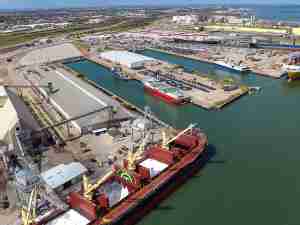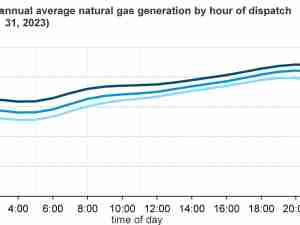Russia’s seaborne crude exports gave up all of the previous week’s gains as maintenance work at the Baltic port of Primorsk and strong winds around Kozmino on the Pacific Coast hit shipments from the two most important oil ports.
A three-day gap in the loading program for Primorsk indicates that the work there was planned, but it still cut flows to the lowest since September. To the east, high winds limited loadings from Kozmino again last week, after similar disruption earlier this month. Gusts reached more than 40 miles an hour in the second half of the week.
The maintenance and adverse weather combined to leave weekly crude exports comfortably below the level that Moscow pledged to OPEC+ partners as part of a wider drive to curb output and support prices. Shipments were in line with that target on the more stable four-week measure.
Ukraine’s drone attacks on Russian refineries have reduced processing capacity by somewhere around 600,000 barrels a day, according to estimates from Gunvor Group Ltd. That should boost the volume of crude for export, unless oil companies reduce production rates until the plants are repaired.
Separately, sanctions on some tankers hauling Russian crude and several of the companies involved in the trade are having an impact, though so far overall flows have not been reduced on any significant scale.
Russia’s state oil tanker company PJSC Sovcomflot said that tougher US measures are putting pressure on its operations, the latest sign that the measures are complicating the delivery of the nation’s petroleum.
Two tankers carrying Russian flagship Urals crude have been idling off the west coast of India for more than three weeks without any indication of when they will unload. Both loaded about 700,000 barrels of Urals from Primorsk in January. Indian oil refiners are on track to take the most American crude in almost a year, after tighter enforcement of US sanctions crimped trade with Russia and forced processors to look elsewhere for supply.
Tankers transporting Russian barrels have been doing strange things following a ramp-up in US sanctions. Ships waiting to discharge Sokol crude at Indian refineries turned back in mid-December, with many subsequently diverting to Chinese ports.
Flows to India of Russia’s key Pacific crude grades, ESPO and Sokol, have all but dried up. The last cargo of either grade delivered to the country was loaded in January. At its peak about a year ago, the flow was in excess of 500,000 barrels a day.
The gross value of Russia’s crude exports fell back from the previous week’s multi-month high, dropping to $1.48 billion in the seven days to March 17 from $1.86 billion the period to March 10.
Flows by Destination
Russia’s seaborne crude flows in the week to March 17 fell back by 730,000 barrels a day to 2.97 million. The less volatile four-week average also dropped, slipping by about 40,000 barrels a day to 3.28 million barrels a day.
Weekly shipments were about 620,000 barrels a day below the average seen in May and June, or about 320,000 barrels a day lower than Russia’s first quarter target. The four-week average was in line with the target.
All figures exclude cargoes identified as Kazakhstan’s KEBCO grade. Those are shipments made by KazTransoil JSC that transit Russia for export through the Black Sea port of Novorossiysk and the Baltic’s Ust-Luga and are not subject to European Union sanctions or a price cap.
The Kazakh barrels are blended with crude of Russian origin to create a uniform export grade. Since Russia’s invasion of Ukraine, Kazakhstan has rebranded its cargoes to distinguish them from those shipped by Russian companies.
-
Asia
Observed shipments to Russia’s Asian customers, including those showing no final destination, edged higher to 2.89 million barrels a day in the four weeks to March 17, up from a revised 2.86 million in the previous four-week period.
About 1.35 million barrels a day of crude was loaded onto tankers heading to China. The Asian nation’s seaborne imports are boosted by about 800,000 barrels a day of crude delivered from Russia by pipeline, either directly, or via Kazakhstan.
Flows on ships signaling destinations in India averaged about 1.13 million barrels a day.
Both the Chinese and Indian figures will rise as the discharge ports become clear for vessels that are not currently showing final destinations.
The equivalent of about 295,000 barrels a day was on vessels signaling Port Said or Suez in Egypt, or are expected to be transferred from one ship to another off the South Korean port of Yeosu. Those voyages typically end at ports in India or China and show up in the chart below as “Unknown Asia” until a final destination becomes apparent. This figure includes stranded Sokol crude cargoes that are still waiting to discharge after failing to find homes in India since mid-December.
The “Other Unknown” volumes, running at about 80,000 barrels a day in the four weeks to March 17, are those on tankers showing no clear destination. Most of those cargoes originate from Russia’s western ports and go on to transit the Suez Canal, but some could end up in Turkey. Others could be moved from one vessel to another, with most such transfers now taking place in the Mediterranean, off the coast of Greece.
Europe and Turkey
Russia’s seaborne crude exports to European countries have ceased.
With flows to Bulgaria halted at the end of last year, Turkey is now the only short-haul market for shipments from Russia’s western ports.
Exports to Turkey slipped to about 365,000 barrels a day in the four weeks to March 17. That’s the lowest in five weeks and down from a revised 443,000 barrels a day in the period to March 10.
Vessel-tracking data are cross-checked against port agent reports as well as flows and ship movements reported by other information providers including Kpler and Vortexa Ltd.
Export Value
Following the abolition of export duty on Russian crude, we have begun to track the gross value of seaborne crude exports, using Argus Media price data and our own tanker tracking.
The gross value of Russia’s crude exports fell back from the previous week’s multi-month high, dropping to $1.48 billion in the seven days to March 17 from $1.86 billion in the period to March 10. Four-week average income was also down, falling by about $18 million to $1.63 billion a week. The four-week average is still well off its peak of $2.17 billion a week, reached in the period to June 19, 2022. The highest it reached last year was $2 billion a week in the period to Oct. 22.
During the first four weeks after the Group of Seven nations’ price cap on Russian crude exports came into effect in early December 2022, the value of seaborne flows fell to a low of $930 million a week, but soon recovered.
The chart above shows a gross value of Russia’s seaborne oil exports on a weekly and four-week average basis. The value is calculated by multiplying the average weekly crude price from Argus Media Group by the weekly export flow from each port. For shipments from the Baltic and Arctic ports we use the Urals FOB Primorsk dated, London close, midpoint price. For shipments from the Black Sea we use the Urals Med Aframax FOB Novorossiysk dated, London close, midpoint price. For Pacific shipments we use the ESPO blend FOB Kozmino prompt, Singapore close, midpoint price.
Export duty was abolished at the end of 2023 as part of Russia’s long-running tax reform plans.
Ships Leaving Russian Ports
The following table shows the number of ships leaving each export terminal.
A total of 27 tankers loaded 20.8 million barrels of Russian crude in the week to March 17, vessel-tracking data and port agent reports show. That was down by about 5.1 million barrels from the previous week.
Shipments from Russia’s Pacific terminal at Kozmino were hampered by high winds, according to data from visualcrossing.com, while a three-day gap in the loading schedule for Primorsk indicates that the port was likely closed for maintenance work.
All figures exclude cargoes identified as Kazakhstan’s KEBCO grade. One cargo of KEBCO was loaded at Novorossiysk a during the week.










